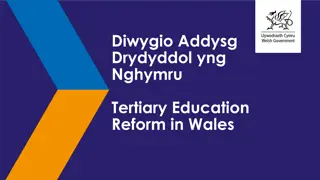Exploring E-Learning: Benefits and Strategies for Higher Education in Iraq
Dive into the world of e-learning with this comprehensive module focusing on the need for online education in higher education institutions in Iraq. Learn about the basic principles, best practices, and instructional strategies for successful online instruction. Discover the role of technology in teaching and learning, and explore common e-learning methodologies and terms. Engage in discussions on why e-learning is crucial for student progress and skills-building in today's educational landscape. Join the session to reflect, discuss, and enhance your understanding of e-learning in the context of Iraq's higher education needs.
Download Presentation

Please find below an Image/Link to download the presentation.
The content on the website is provided AS IS for your information and personal use only. It may not be sold, licensed, or shared on other websites without obtaining consent from the author. Download presentation by click this link. If you encounter any issues during the download, it is possible that the publisher has removed the file from their server.
E N D
Presentation Transcript
1 Introduction to E-Learning Unit 1, Module 1, April 30 2020
Welcome and Introduction 2 Welcome video -
By the end of this session, you will be able to: Demonstrate need for e-learning across higher education institutions Demonstrate understanding of basic principles and best practices in e- learning Identify transferrable instructional strategies for the online classroom Describe the roles, responsibilities, knowledge, and skills needed for a successful online instruction Describe how technology can benefit teaching and learning 3 Session Objectives
4 Use Thumbs Up or Thumbs Down to respond: Poll How many have participated as a student in an online class? How many have led an online class or training as an instructor?
Introduction to E-Learning Methodologies 5 E-learning: Education or training that is delivered online through a computer or other digital device Some common e-learning methodologies include: Asynchronous Self-paced and synchronous (most MOOCS) Facilitated and synchronous Blended
Introduction to Common E-Learning Terms 6 Some common e- learning terms include: Learning Management System (LMS) Video Conferencing Sytem Module MOOC
7 Why is e-learning needed for higher education institutes in Iraq today? Discuss Reflect for one minute, then write your answer in the chat box in Arabic or English!
Current Need: E-learning in Iraq Essential for student progress- New world of learning and teaching Most efficient way to complete the academic year Reach and Scale A coordinated e-learning approach allows for reaching most students possible Skills-building- 21st Century Skills Opportunities for faculty and students to learn both content and digital skills more and more necessary in both educational and workplace settings Constructive Engagement While students are home, allows them the opportunity to continue to learn and interact with one another and faculty 8
Basic Principles and Best Practices in E-learning 9 Question: Which of the principles and practices below should be adapted for the e-learning environment? Enter your answer in the chat box! 1. Course and Lesson Structure 2. Methods of Instruction 3. Instructional Materials 4. Class Activities 5. Student Engagement 6. Assessment and Evaluation 7. Accessibility of Materials
10 Many of you are already trying e-learning. What have you already started adapting for e- learning and what are you currently doing? Adapting to E- Learning: Pause and Reflect What are the areas could you start to adapt now to prepare for teaching courses online? We will come back to this again later in the module!
Basic Principles and Best Practices in E-learning 11 Methods of Instruction This takes planning. Plan carefully, think through the details, and keep it varied and simple! Materials should be high-quality with engaging visuals Use standard templates or structure! Instructional Materials Activities are appropriate to the subject level, and provide opportunity for interaction Class Activities Spark students motivation, interest and curiosity with engaging materials relevant to real-world application Student Engagement Assessment and Measurement Assessments measure stated learning objectives Assessment methods are varied
Instructional Strategies for the Online Classroom 12 Focus on Active Learning Use a mix of video, collaborative assignments, discussion, hands-on exercises, chat, and peer review Chunk Your Lessons Break down your lessons into 10 minute chunks of information and activities and vary the presentation approach! Manage Your Time Be responsive to students but set clear hours and expectations for virtual office hours, responses to students questions, and feedback on assignments Vary Your Assignments As students get more comfortable with digital technology, incorporate innovative assignments and assessments into the classroom!
Make the Switch to Remote Teaching 13 Google ( Classroom ) Google . Classroom / - __ . . Peralta WhatsApp . Practical Example Create a pre-recorded video using your mobile phone that you post on Google Classroom or share via What s App. / . . WhatsApp YouTube ( . ! )"... . ! . WhatsApp Use What s App group to allow students to ask questions A1 . 10 - 15 Zoom / Google Doc. Word Doc Online
Instructor Role Are you facilitating learner-centered lessons, taking students knowledge, skills and needs into account? Do you use different online strategies rather than traditional lecturing? Instructor Responsibilities Do you provide appropriate instruction and materials that meet the learning needs and relate to your students reality? Is your instructional approach considerate of different technical abilities, bandwidth access, and hearing or visual abilities? Are your language and online images inclusive? 14 Successful Online Instruction: Reflection Questions, Part 1
Knowledge and Skills Do your modules involve activities which require the learner to be active, creative, and think critically? 15 Successful Online Instruction: Reflection Questions, Part 2 Do you know how your content and activities will lead to achieving your learning objectives? Does your content include participant reflection and application of materials to their particular contexts?
16 1. How has technology affected your life? Pause and Reflect 2. What is one way technology has saved you time and made you more efficient? 3. What are other instructors doing with technology in the classroom that you d like to try?
Module 1 Key Takeaways 17 1. E-learning is essential to meeting current educational needs in Iraq Best practices in e-learning include innovative ways of structuring course design, teaching strategy, methods for student engagement, and assessment Effective instructional strategies include a focus on active learning and chunking lessons Successful online instructors design materials that meet learning needs and relate to students current reality Technology can increase opportunities for students to collaborate and display creativity! 2. 3. 4. 5.
18 True or False: A learning management system (LMS) is a platform that include communication, content delivery, and assessment tools to facilitate the teaching and learning process. Quiz Question #1 Type T for true or F for false in the chatbox!
Examples of e-learning instructional strategies include (note all that apply): 19 A. Varying your lesson with a mix of video, discussion, hands-on activities, and chat to promote active learning Quiz Question #2 B. Finding creative ways for assessment C. Posing questions and asking students to pause and reflect D. All of the above
20 Choose the statement that best reflects what we know about technology, teaching and learning: Quiz Question #3 1. Instructors must be absolute experts with technology to start out with e-learning. 2. Technology is a tool to support teachers in their effort to increase student learning. 3. In facilitated and synchronous learning, learners engage on their own time at their own pace.
21 Please complete assignment by What s Next? Sunday, May 3rd Next module topic: Conceptual Framework for E-Learning Design Questions and Answers
22 Review the Best Practices in E-Learning Checklist and the Making the Switch to Remote Learning guide. Share your response in your Google Classroom (see Unit 1, Homework 1) Homework: E- Learning Best Practices 1. What areas have you have already adapted well to e-learning? How? 2. What 3 new areas will you use in teaching your online class? How will you incorporate this into your class? 1. What two areas are you excited to improve on through this training course? Why?























